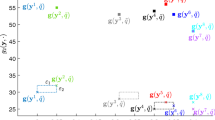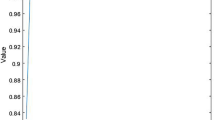Abstract
This study develops a bi-objective method for burn-in decision makings with a view to achieving an optimal trade-off between the cost and the performance measures. Under the proposed method, a manufacturer specifies the relative importance between the cost and the performance measures. Then a single-objective optimal solution can be obtained through optimizing the weighted combination of these two measures. Based on this method, we build a specific model when the performance objective is the survival probability given a mission time. We prove that the optimal burn-in duration is decreasing in the weight assigned to the normalized cost. Then, we develop an algorithm to populate the Pareto frontier in case the manufacturer has no idea about the relative weight.




Similar content being viewed by others
References
Balachandran, K. R., & Radhakrishnan, S. (2005). Quality implications of warranties in a supply chain. Management Science, 51(8), 1266–1277.
Bebbington, M., Lai, C. D., & Zitikis, R. (2007). Optimum burn-in time for a bathtub shaped failure distribution. Methodology and Computing in Applied Probability, 9(1), 1–20.
Cha, J. H. (2006). A stochastic model for burn-in procedures in accelerated environment. Naval Research Logistics, 53(3), 226–234.
Cha, J. H., & Finkelstein, M. (2010a). Burn-in by environmental shocks for two ordered subpopulations. European Journal of Operational Research, 206(1), 111–117.
Cha, J. H., & Finkelstein, M. S. (2010b). Stochastically ordered subpopulations and optimal burn-in procedure. IEEE Transactions on Reliability, 59(4), 635–643.
Chanta, S., Mayorga, M. E., & McLay, L. A. (2011). Improving emergency service in rural areas: a bi-objective covering location model for EMS systems. Annals of Operations Research. doi:10.1007/s10479-011-0972-6.
Jiang, R., & Jardine, A. K. S. (2007). An optimal burn-in preventive-replacement model associated with a mixture distribution. Quality and Reliability Engineering International, 23(1), 83–93.
Jiang, R., & Murthy, D. N. P. (2009). Impact of quality variations on product reliability. Reliability Engineering & Systems Safety, 94(2), 490–496.
Kim, K. O., & Kuo, W. (2005). Some considerations on system burn-in. IEEE Transactions on Reliability, 54(2), 207–214.
Kim, K. O., & Kuo, W. (2009). Optimal burn-in for maximizing reliability of repairable non-series systems. European Journal of Operational Research, 193(1), 140–151.
Kuo, W. (1984). Reliability enhancement through optimal burn-in. IEEE Transactions on Reliability, 33(2), 145–156.
Kuo, W., Chien, W. T. K., & Kim, T. (1998). Reliability, yield, and stress burn-in. Dordrecht: Kluwer Academic.
Linz, P. (1985). Analytical and numerical methods for Volterra equations. Philadelphia: SIAM.
Mi, J. (1994). Maximization of a survival probability and its application. Journal of Applied Probability, 31(4), 1026–1033.
Mi, J. (1996). Minimizing some cost functions related to both burn-in and field use. Operations Research, 44(3), 497–500.
Mi, J. (1999). Comparisons of renewable warranties. Naval Research Logistics, 46(1), 91–106.
MIL-STD-883G (2006). Test methods and procedures for microelectronics. Washington: Department of Defense.
Murthy, D. N. P., Rausand, M., & Virtanen, S. (2009). Investment in new product reliability. Reliability Engineering & Systems Safety, 94(10), 1593–1600.
Pohl, E. A., & Dietrich, D. L. (1999). Optimal stress screening strategies for multi-component systems sold under warranty: the case of phase type lifetimes. Annals of Operations Research, 91, 137–161.
Reichheld, F. F., & Teal, T. (2001). The loyalty effect: the hidden force behind growth, profits, and lasting value. Harvard: Harvard Business Press.
Saaty, T. L. (1994). Fundamentals of decision making and priority theory with the analytic hierarchy process. Pittsburgh: RWS Publications.
Shafiee, M., Finkelstein, M., & Zuo, M. J. (2013). Optimal burn-in and preventive maintenance warranty strategies with time-dependent maintenance costs. IIE Transactions, 45(9), 1024–1033.
Sheu, S. H., & Chien, Y. H. (2004). Minimizing cost-functions related to both burn-in and field-operation under a generalized model. IEEE Transactions on Reliability, 53(3), 435–439.
Sheu, S. H., & Chien, Y. H. (2005). Optimal burn-in time to minimize the cost for general repairable products sold under warranty. European Journal of Operational Research, 163(2), 445–461.
Singpurwalla, N. D. (2006). Reliability and risk: a Bayesian perspective. West Sussex: Wiley.
Tortorella, M. (2005). Numerical solutions of renewal-type integral equations. INFORMS Journal on Computing, 17(1), 66–74.
Wu, S., & Zuo, M. J. (2010). Linear and nonlinear preventive maintenance models. IEEE Transactions on Reliability, 59(1), 242–249.
Ye, Z. S., Tang, L. C., & Xie, M. (2011). A burn-in scheme based on percentiles of the residual life. Journal of Quality Technology, 43(4), 334–345.
Ye, Z. S., Xie, M., Tang, L. C., & Shen, Y. (2012). Degradation-based burn-in planning under competing risks. Technometrics, 54(2), 159–168.
Yuan, T., & Kuo, Y. (2010). Bayesian analysis of hazard rate, change point, and cost-optimal burn-in time for electronic devices. IEEE Transactions on Reliability, 59(1), 132–138.
Yun, W. Y., Lee, Y. W., & Ferreira, L. (2002). Optimal burn-in time under cumulative free replacement warranty. Reliability Engineering & Systems Safety, 78(2), 93–100.
Zhu, X., & Kuo, W. (2012). Importance measures in reliability and mathematical programming. Annals of Operations Research. doi:10.1007/s10479-012-1127-0.
Acknowledgements
The authors thank the editor and four anonymous reviewers for their critical and constructive comments which have considerably helped in the revision of an earlier version of the paper. This work is partially supported by a grant from City University of Hong Kong (Project No. 9380058).
Author information
Authors and Affiliations
Corresponding author
Rights and permissions
About this article
Cite this article
Ye, ZS., Tang, LC. & Xie, M. Bi-objective burn-in modeling and optimization. Ann Oper Res 212, 201–214 (2014). https://doi.org/10.1007/s10479-013-1419-z
Published:
Issue Date:
DOI: https://doi.org/10.1007/s10479-013-1419-z




